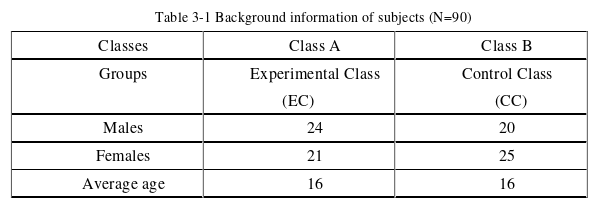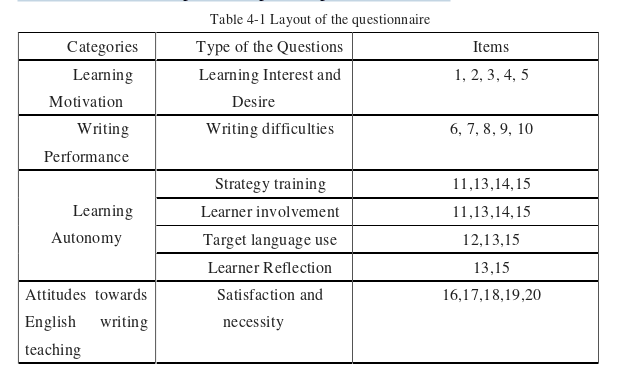本文是一篇英语论文,笔者认为混合学习促进了学生的英语写作动机,提高了写作成绩,提高了他们在英语写作学习中的自主性。这对教师提出了更高的要求。
Chapter 1 Introduction
1.1 Background of the Study
The importance of English writing determines that more emphasis must be placed on it for students, especially for senior high school students facing college entrance exams. The English Curriculum Standard for General Senior High School (2020 version) emphasizes that English writing focuses on cultivating interest, providing demonstrations and training thinking. Therefore, English writing teaching in senior high school cannot be ignored.

Nevertheless, the present situation of English writing teaching in senior high school is far from optimistic. Most teachers attach more attention to the result of writing than to the process of writing. They usually assign writing as homework after class and give scores with remarks or pick out a relatively excellent English writing as an example for the students to appreciate and learn. Although teachers devote much time to instruction and correction on students’ writing, they still get confused with the reason why students make little progress. For students, they lack initiative, enthusiasm, and creativity in English writing as they are always treated as passive receivers instead of learning dominant roles. In such an English learning environment, students' motivation to learn English writing is low, their English performance is not satisfactory, and their learning autonomy is weak. In conclusion, the preferred results of the English writing teaching in senior high school have not been accomplished yet, and the problems students encounter in learning to write also need to be addressed urgently. Therefore, it is necessary to improve the current English writing teaching mode.
1.2 Purpose and significance of the study
This study is aimed to explore the validity and availability of the application of blended learning in senior high school English writing teaching. Although blended learning has been introduced to our country and gradually applied to teaching, there are few theoretical and empirical studies on the senior high English writing teaching applied with blended learning. In this study, blended learning is applied in senior high school English writing teaching by means of the theoretical expedition and empirical research. Through teaching experiments, we can verify whether blended learning has positive impacts on senior high students’ English writing.
It is of theoretical significance that this study adopts blended learning and carries out the practice of English writing teaching in senior high school, which not only deepens the understanding of blended learning, but also further expands blended learning to the basic field of education, especially, to senior high school English writing teaching. Through empirical research, it proves the validity and availability of the application of blended learning in senior high school English writing teaching, which helps to provide an alternative to the English writing teaching approach as a complement to traditional teaching modes. Therefore, this study has vital theoretical reference value for carrying out the research on senior high school English writing teaching.
It is of practical significance that this study not only contributes to teachers in teaching reference by designing the teaching steps applied with blended learning, but also fruits the teaching results in terms of the improvement of students’ motivation to learn English writing, writing performance and autonomy in English writing. Therefore, this study has important practical value for writing teaching in the future.
Chapter 2 Literature Review
2.1 Definitions of Blended Learning
"Blended learning" was a vague term initially and covered a variety of different combinations of technologies and pedagogical methods. In Bonk and Graham’s (2006) book, Graham challenged the breadth and ambiguity of the term's definition, and defined "blended learning as a combination of face-to-face instruction with computer-mediated instruction to facilitate interactive and reflective higher-order learning."
From a corporate perspective, Singh & Reed (2001) defined blended learning as being a learning program, where more than one delivery mode was being used with the objective of optimizing the learning outcome and cost of program delivery. Valiathan (2002) suggested that they may include “face-to-face classrooms, live e-learning, and self-paced learning.” Reid-Young (2003) also provided us with a set of delivery modes which differed slightly from Valiathan (2002). “It may range from classroom sessions to mentoring arrangements or the support of a subject matter expert in the same office or area.”
From higher education perspective, Banados (2006) defined blended learning as: “a combination of technology and classroom instruction in a flexible approach to learning that recognizes the benefits of delivering some training and assessment online but also uses other modes to make up a complete training program which can improve learning outcomes and/or save costs”. And similar definitions were given by MacDonald (2006)
2.2 Overview of Relevant Studies on Blended Learning
In this section, the origins and development of blended learning are briefly reviewed, and relevant theoretical and empirical researches on blended learning are reviewed in relevant studies abroad and at home.
2.2.1 Origins and Development of Blended Learning
Blended learning came with the development of technology-based training (Josh Bersin, 2004). From the 1960s to 1970s, mainframe-based computer-based training came to solve the biggest challenge of the lack of scale of instructor-led training. From the 1980s to the 1990s, companies started to use satellite of ground-based video to extend the live instructor. Learners could sit in a classroom, watch the instructor on TV, chat and interact with other students, and even ask the instructor questions. In the early 1990s, CD-ROMs emerged as a dominant form of providing technology-based learning. From 1980 till now, the first generation of web-based training virtual classroom, which was so-called e-learning, emerged. These new technologies created an HTML and Browser-based platform that solved many of the problems that plagued CD-ROMs. From 2002 till now, self-study (asynchronous) options included web-based courseware, simulations, and job aids. Live-study(synchronous) options included webcasting, live video, conference calls, and instructor-led training, which were formed in the integrated blended learning.
Chapter 3 Research Methodology ............................... 18
3.1 Research Questions ...................................... 18
3.2 Research Subjects ...................................... 18
3.3 Research Instruments ................................. 18
Chapter 4 Results and Discussion ........................................ 29
4.1 Analysis of Questionnaires................................. 29
4.1.1 Analysis of the Questionnaire before the experiment ........................... 30
4.1.2 Analysis of the Questionnaire after the experiment .............................. 35
Chapter 5 Conclusion .............................. 49
5.1 Major Findings ........................................ 49
5.2 Implications ................................. 50
Chapter 4 Results and Discussion
4.1 Analysis of Questionnaires
There were two sets of questionnaires analyzed before and after the experiment. They covered four aspects of English writing teaching: students’ learning motivation towards English writing; students’ writing difficulties; students’ writing autonomy and their attitude towards English writing teaching. (See table 4-1)

Chapter 5 Conclusion
5.1 Major Findings
In this paper, blended learning is applied to the writing teaching of senior high school. After a term of the experiment, it is found that blended learning shows positive impact on senior high school English writing. The major findings are presented as follows:
Firstly, blended learning has a positive impact on senior high school students’ learning motivation in English writing. Before the experiment of blended learning, students are not motivated to write. However, after the experiment of blended learning, it is found that students like to write and finish the tasks on time. what’s more, they become more willing to involve themselves in teaching activities online and offline and communicate with the teacher and others to actively solve writing difficulties, which promotes their confidence in writing proficiently and noticeably.
Secondly, blended learning makes a great improvement for senior high school students’ English writing performance. Students of EC get higher scores than those in traditional face-to-face classroom teaching. Compared with traditional face-to-face classroom teaching, blended learning enables students to master writing strategies with obvious improvement in content, organization, grammar, vocabulary, and connection. Via online and offline activities, students can understand to analyze the writing material before writing, and make the content rich and logical. Also, more than 5 keywords underlined in the given short passage can be applied suitably. Besides, their organization is in high degree of harmony with the given short passage. What’s more, their grammar becomes rich and accurate within sentences, and their connecting elements are effectively used between sentences to generate a smooth and compact structure of the writing under the help of classmates, teachers and their own reflection. As a result, through online reconsolidation after class, students become capable of giving writing advice on their own.
reference(omitted)
